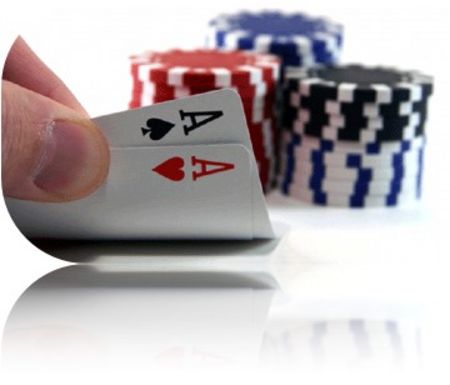Review
 One of the more common situations on the flop is playing top pair or an overpair.
The relative strength of your hand depends on the following factors:
One of the more common situations on the flop is playing top pair or an overpair.
The relative strength of your hand depends on the following factors: -
- How high your pair is
- How high your kicker is when holding top pair
- The number of players playing the hand
- The possible strength of your opponents' hands, especially in a raised pot
- The flop type. Flops that are more dangerous than others include:
A high or low pair
Two- or three-suited
Two- or three-connected
Two or more cards 9 or above
A rainbow flop with one high card is a good flop for top pair or an overpair.
- Although top pair is usually a good hand with this type of flop, some common
situations where you should consider folding include:
The pot is raised before you act and you have a weak kicker.
Several players pay a bet on the flop and you have a weak kicker.
Several players pay a bet on the flop and your lop pair is not very high.
The bettor is a tight player who never bluffs and you hold a weak
kicker.
- Whenever the pot is small and you hold a strong hand that is not very
vulnerable to overcards, you can either play your hand aggressively on the
flop, or wait until the turn to raise. If the pot is large, choose the best strategy
to drive out your opponents.
- With pairs more vulnerable to overcards, choose the best strategy to drive
out your opponents. This might include betting out, check- raising, raising, or
just calling and waiting to the turn to try and drive out your opponents.
- Try to avoid just checking and calling your borderline hands to the river since
this can be much more expensive than gaining information early in the hand
that might allow you to safely fold.
Strategies for a rainbow flop of, all rags are similar to those when the flop includes
a high card, but low to medium pairs are always more vulnerable to overcards.
- When you hold a small top pair, important considerations include:
The number of opponents
The size of the pot
Your kicker card
- Against several opponents in a raised pot, top pairs are rather weak since
you could already be beat by an overpair and it is nearly impossible to get
many opponents to fold their overcard draws.
Two-suited flops either increase the value of your pair when you have a flush draw,
or give your opponents a better chance to draw out on you.
- When you hold a flush draw, your borderline hands are now playable and
you are less worried about driving out opponents.
- When you don't have a flush draw, you should be more inclined to check and
fold your borderline hands than otherwise.
- With your stronger hands, be careful not to give a free card.
A three-suited flop is always dangerous, unless you happen to have a flush draw
with one of the top two remaining suited cards.
-
With a high flush draw, slowplaying is an option if your pair is not vulnerable
to overcards. With pairs vulnerable to overcards. generally bet or raise to try
and drive out your opponents unless you want to keep players in the hand
when the pot is small.
- You should proceed cautiously when you don't have a flush draw, especially
when your pair is not very high or your kicker is weak. Strategy is usually
dependent on how many opponents you are against.
Two-connected flops can give your opponents two pair or open-ended or gut-shot
straight draws along with overcards.
-
Almost always raise your strong hands to make it two small bets for the
remaining opponents who may be on gut-shot of other weak draws.
- Always try to protect a vulnerable pair if possible. You may need to fold your
weaker holdings if there is a lot of action on the flop.
A three-connected flop can be dangerous, especially with medium to high cards. An
opponent could already have a straight, set, two pair or a strong draw.
- With a straight draw, generally bet out or raise. You can consider slowplaying
if the pot is small and your hand is not too vulnerable to overcards.
- When you don't have a straight draw, usually bet out or raise against a lone
opponent. With several players in the hand, consider checking to see what
develops behind you, especially if your pair is vulnerable to overcards or your
kicker is weak.
Flops of all high cards make top pairs and overpairs vulnerable to straights, sets,
two pair, and straight draws.
- Consider folding against several opponents unless you have some type of
straight draw also, especially if you have a weak kicker.
- Usually bet out against one or two opponents.
You always need to worry about trips with a pair on the flop, especially when the
pair is high. Strategy often depends on whether or not you need to protect your pair.
- Consider checking against several opponents when you hold a weak kicker
or a pair vulnerable to overcards to see what develops behind you.
- You should generally fold when two or more players call the flop or you call
and a third opponent raises.
- You can generally call with a strong kicker or strong pair against a lone
opponent when you are unsure whether or not your opponent has trips.
- Check-raising against several opponents is risky.
- Generally bet out pairs that are vulnerable to overcards against one or two
opponents to avoid giving a free card.
- Consider raising with your strong pairs since most players slowplay trips and
their bet probably indicates a weak hand or a bluff.
- When you are unsure if your hand is the best and your pair is relatively
strong, consider raising to try for a free card.
A low pair on the flop is played practically the same as a high pair on the flop,
except that you can sometimes decrease the risk that someone is holding trips.
- In those cases where you are not too concerned about trips, you can play
your hand similarly to how you play a rainbow flop of all rags or with one high
card.
- When flopping a small top pair from the blinds generally bet out against one
or two opponents and check against four or more. Against three opponents,
tend to bet out in a tight game and check in a loose game.
NEXT...Middle end Bottom Pair

